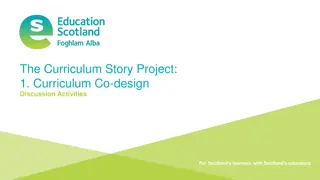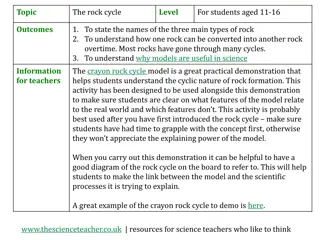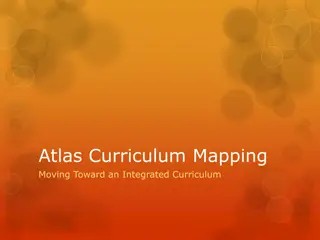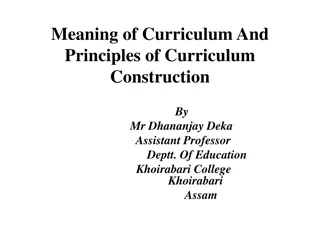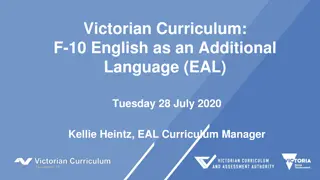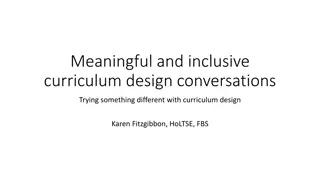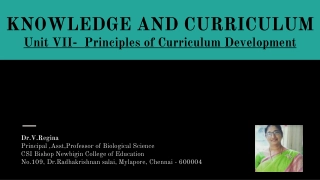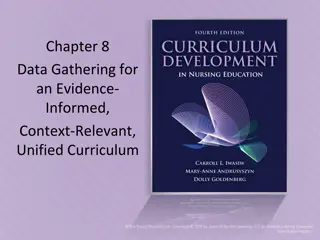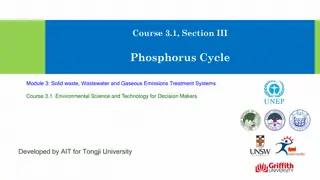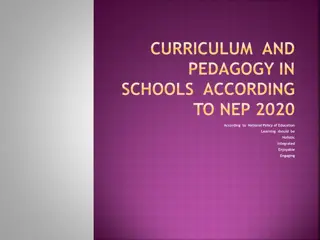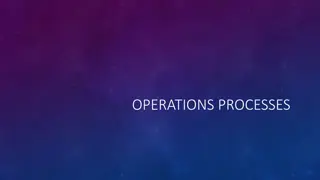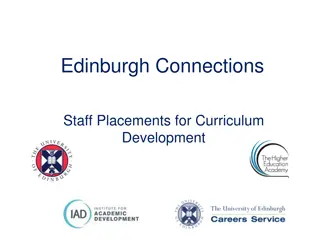Transforming Learning Through Curriculum Design Cycle Discussion Activities
Explore the benefits and challenges of curriculum planning using a design cycle with practical activities and discussion points. Discover how to enhance interdisciplinary projects and create collaborative spaces for educators and learners to plan together. Learn how to apply learning provocations to engage learners and kickstart IDL projects effectively.
Download Presentation

Please find below an Image/Link to download the presentation.
The content on the website is provided AS IS for your information and personal use only. It may not be sold, licensed, or shared on other websites without obtaining consent from the author. Download presentation by click this link. If you encounter any issues during the download, it is possible that the publisher has removed the file from their server.
E N D
Presentation Transcript
The Curriculum Story Project: 3. The Curriculum Design Cycle Discussion Activities For Scotland's learners, with Scotland's educators Transforming lives through learning The Curriculum Story Project: 3. The Curriculum Design Cycle
How to use this download pack The discussion and practical activities in this pack connect to the case studies and ideas around interdisciplinary learning of The Curriculum Story Project 3: The Curriculum Design Cycle. While there is value in using them as standalone resources, we encourage teams to read the case studies, together, as part of their own reflective practice. From 2020-22, The Curriculum Story Project from Education Scotland brought together nearly 200 practitioners to understand the components, processes, and thinking behind successful interdisciplinary learning and the development of broader learner pathways. The case studies and activities are designed by NoTosh, a firm specialised in helping people think differently and choose the way they learn and work. Transforming lives through learning The Curriculum Story Project: 3. The Curriculum Design Cycle
Discussion activities First read the case studies for The Curriculum Story Project 3: The Curriculum Design Cycle. Then use one of these discussion points for a learning session or team meeting. Discussion 1. What are the benefits of using a design cycle for curriculum planning and progression? For example, how could the process of a design cycle enhance current IDL projects, contexts or courses in your setting? Discussion 2: What are the challenges for ensuring a genuinely collaborative approach to planning using a design cycle? For example, how would you invest in the time to create collaborative spaces for educators and learners to plan together using a design cycle? Session 3: How could you apply the practice of learning provocations to kickstart and enhance Interdisciplinary (IDL) projects in your setting? For example, could you reflect on some recent IDL projects and suggest a variety of provocations that you could use at different intervals to hook and engage learners? For Scotland's learners, with Scotland's educators For Scotland's learners, with Scotland's educators The Curriculum Story Project: 3. The Curriculum Design Cycle
The Curriculum Story Project: 3. The Curriculum Design Cycle Practical Activities For Scotland's learners, with Scotland's educators Transforming lives through learning The Curriculum Story Project: 3. The Curriculum Design Cycle
1. Adopt and adapt an enquiry design cycle A curriculum design cycle is a method of enquiry that emphasise the importance of collaboration and the learner s role in the process of curriculum-making. The concept of curriculum-making is central to the refreshed narrative for Curriculum For Excellence. Curriculum-making interprets the process of curriculum planning and design as a continuous process. For Scotland's learners, with Scotland's educators For Scotland's learners, with Scotland's educators The Curriculum Story Project: 3. The Curriculum Design Cycle
1. Adopt and adapt an enquiry design cycle A design cycle is a framework of enquiry that adds clarity and a common language to the process of curriculum-making in educational settings. There are many examples of enquiry design cycles that you may wish to adopt or adapt to fit your context. The international educator, Kath Murdoch, envisages curriculum design as a journey of inquiry . She has created a 5 stage framework which begins with concept-driven big ideas and compelling questions and contexts. The 5 stages are: 1) Tuning In, 2) Finding Out, 3) Sorting Out, 4) Going Further and, 5) Reflecting and Acting 1) Prepare 5 large sheets of paper. Title the papers with each of the stages. 2) Select an IDL project or recent curriculum design project from your setting. Use the headings and questions to reflect on the collaborative process, the involvement of learners and the differences in approach and possible gaps when compared to the enquiry design cycle. 3) What do you like and what do you dislike about the process? Compare with other models. For Scotland's learners, with Scotland's educators For Scotland's learners, with Scotland's educators The Curriculum Story Project: 3. The Curriculum Design Cycle
With permission pending For Scotland's learners, with Scotland's educators The Curriculum Story Project: 3. The Curriculum Design Cycle 3. The Curriculum Design Cycle The Curriculum Story Project:
1. Adopt and adapt an enquiry design cycle Investigate other models adaptive for a curriculum design cycle. 1) NoTosh Design Thinking process: https://notosh.com/notosh-design-thinking 2) Project Based Learning 7 Design Elements: https://www.pblworks.org/what-is-pbl/gold- standard-project-design 3) Outdoor Journeys an enquiry cycle for Outdoor Learning: https://www.outdoorjourneys.co.uk/ 4) John Muir Award Discover, Explore, Conserve, Share: https://www.johnmuirtrust.org/john-muir-award/get-involved/four-challenges 5) The LAUNCH Cycle Design Thinking Framework: https://spencerauthor.com/the- launch-cycle/ 6) Sketchnote examples of enquiry cycles: https://www.trevormackenzie.com/sketchnotes 7) Project Zero Thinking Routine Toolbox resources to support curriculum-making and a design cycle: http://www.pz.harvard.edu/thinking-routines For Scotland's learners, with Scotland's educators For Scotland's learners, with Scotland's educators The Curriculum Story Project: 3. The Curriculum Design Cycle
2. Create a Project Nest to document the progress of the design cycle A Project Nest is a visual space, physically or virtually, where the thinking and progress of a curriculum design cycle can be documented, shared and discussed. It works as a continual reminder of the collaborative process and a centralised hub for educators and learners to visit where they can keep their ideas and enthusiasm bubbling away. A Project Nest can also be a critical component of an IDL project s initial phase, linking questions and research to the development of ideas and learning activities. Think of ways to create your own Project Nest in your setting. Here are some suggestions: 1. Decide whether you need to use a single wall, a whole room or several set display areas. 2. Who will see the Project Nest? Make the space as accessible as possible, especially to include learners. 3. Keep items, ideas and resources at eye level it helps to motivate participants and spot connections too. 4. Encourage participants to continually contribute their thoughts to the Project Nest. 5. Invite other colleagues, parents and the wider community to visit the Project Nest provide post-it notes for them to leave comment. 6. Keep it messy! It is a work in progress until you are ready to start organising your ideas. For Scotland's learners, with Scotland's educators For Scotland's learners, with Scotland's educators The Curriculum Story Project: 3. The Curriculum Design Cycle
2. Create a Project Nest to document the progress of the design cycle Collaborative digital learning tools can compliment a physical Project Nest or provide an online space when working remotely or across a large setting. Online Digital Whiteboards Miro - https://miro.com/online-whiteboard/ Google Jamboard - https://jamboard.google.com/ Interactive 360 Virtual Spaces Thinglink - https://www.thinglink.com/edu CoSpaces - https://cospaces.io/edu/ Discuss and Amplify Voices Flipgrid - https://info.flipgrid.com/ Collation tool for collecting and sharing everything in one place Wakelet - https://wakelet.com/ For Scotland's learners, with Scotland's educators For Scotland's learners, with Scotland's educators The Curriculum Story Project: 3. The Curriculum Design Cycle
Education Scotland Denholm House Almondvale Business Park Almondvale Way Livingston EH54 6GA T +44 (0)131 244 5000 E enquiries@educationscotland.gsi.gov.uk For Scotland's learners, with Scotland's educators For Scotland's learners, with Scotland's educators The Curriculum Story Project: 3. The Curriculum Design Cycle
Transforming lives through learning The Curriculum Story Project: 3. The Curriculum Design Cycle


